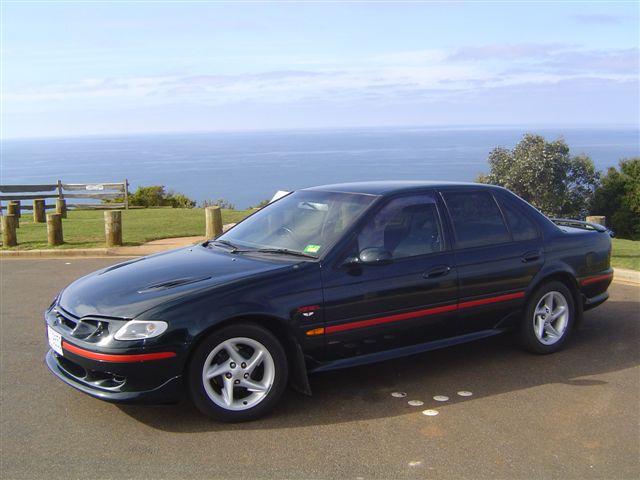Before we get stuck into this comparo, we must admit that the cars are a tad mismatched. Both cars have 6-speed gearboxes, but the Ford has an automatic, while the Holden is a manual. As such, the mid gear roll on performance test from 80km/h went to the Holden.
We thought the super-powerful low end of the Falcon engine, with torque peaking at just 2000rpm, would dice up the Holden. But it seems the new Gen IV 6.0-litre V8 has a much stronger bottom end than the 5.7-litre Gen III engine it replaces; yet from higher speeds the V8 engine is a complete monster, able to generate massive levels of twist.
In terms of everyday use the Falcon wins out because of its lower fuel consumption: the Falcon XR6 Turbo drinks 12.3L/100km while the Commodore SS V uses 14.4L/100km. Other than that there was little to pick between the cars in everyday conditions. The Falcon was perhaps a little better in the city, but the SS V had much more road presence while both offer relatively smooth rides and plenty of creature comforts.
Both are large sports cars measuring around 4.9 metres in length and both are provided with fairly stiff suspension setups and hefty anti-roll bars to match, yet both cars have been tried and tested on Aussie roads and because of this they are great long distance tourers. The highway is not an enemy to these guys, nor are back country roads, and they can soak up distances with effortless ease, as the 6-speed gearboxes they aren’t too bad on fuel consumption when coaxed along in top gear.
On more demanding roads, the SS feels to be the more structurally rigid vehicle, and as such the Falcon is a little bit better on worn out suburban roads as the bumps aren't transmitted through the frame quite so succinctly.
The SS V's rigidity was to be credited to having good body strengthening and torsional design – which bodes well for the new Zeta platform (upon which the VE Commodore range is based) and it's future performance applications, such as the Camaro. A few passing comments concerning the ride in the SS drew attention to the suspension, which came across as somewhat soft in certain situations. Double rate/double acting shocks (e.g. Mitsubishi Evo) would improve it, or even an active system (e.g. RS 4).
At one point during our test the Falcon was following the Commodore and where the latter bottomed out, sparks flying where the quad stainless steel exhaust pipes kissed the bitumen, the Falcon bumped through without contact.
So, while the body of the Commodore SS V is stiffer and offers good feedback, the suspension system has to deal with its extra weight and sometimes this plays against it. It feels as though Holden has ‘Calais-ed’ the SS. The old FE2 felt like a firmer setup.
The Falcon XR6 Turbo is roughly 100kg lighter than the 8-cylinder Commodore SS V (1694kg vs 1790kg), and it shows both in a straight line and round corners. The SS V is never left behind by XR6 Turbo but it just isn't quite as nimble as the Ford.
Through corners, the SS doesn’t feel as big and heavy as it stats would suggest; testament to the new suspension rig which while not as stiff is at least more progressive than the system it replaces.
It tips into corners very precisely, with affirmation. It provides fairly crisp communication through the wheels – the independent front suspension works wonders under duress, and with big 19-inch wheels shod with grippy rubber, the cars feels very planted on the road. It’s a rear wheel drive vehicle too, so there’s a touch of oversteer under marginal throttle inputs and big-time power oversteer if you want it. It can be steered with the throttle if you turn ESP off, but at times it feels unwieldy, and mid-corner bumps in the road will upset its balance and make it shimmey like a mirage on a hot day.
The weakest link for the SS V were the brakes. They were decent, and had a lot more feel than the Commodore Omega we tested earlier in the year, but slowing the cars bulk from the speeds that this car can reach can be a daunting exercise.
In the Falcon the drive is easily explained - very firm and refined. It tracks resolutely through corners for something of this size and bulk, and the up front weight was easily directed and the driving force corresponded as expected.
Even as the rear end gets reacquainted with the laws of physics and slips out a touch toward a drift, our non-safety-pack XR6 Turbo felt quite able and was more inclined to raise an involuntary smile than a smirk or any concern.
The XR6T is sometimes limited by its DSC (dynamic stability control) through corners – it's not as smooth a system as the SS V's ESP. It can even make the Falcon XR6 Turbo understeer a bit. With traction off it's much more ebullient through corners, and generally speaking it's lighter front end makes it easier to throw into corners without the front outside wheel pushing wide.
Compared to the Holden Commodore SS V, the Ford Falcon XR6 Turbo feels lighter on its feet, because there's less weight over the front end (it has a smaller, lighter engine) and the steering feels better in the Falcon – it’s slightly heavier.
While it's true that the Falcon can navigate the apex of a corner slightly better than its rival, both vehicles fire out of corners with colossal force, yet a good deal of poise. The independent rear suspension on the Ford was always top notch, and now the Holden has a new rig which gives it a much better feel while cornering under higher throttle inputs.
With such huge reserves of torque, you can slam the throttle in either of these cars once you’ve passed the apex and, with a slight wiggle of the rear end, the cars seem to pounce forward, spearing ahead with locomotive force. Indeed, these cars are supremely powerful, and a hugely rewarding to drive. In the dry.
The Holden is more demanding to drive and sometimes more rewarding as a result (and sometimes not), where the Falcon can be a lot easier to wring every last drop of performance from. And that typifies the major differences between the two cars – one of them you hold on to with white knuckles, and the other is slightly less insane.
The SS V has more bodyroll than the XR6 Turbo, and given its extra weight and slightly softer suspension this is understandable. Drivei n the SS is very light, with a rigid race car feel to the chassis, but the suspension is geared more towards luxury than race, as is reflected in the electronic safety systems.

The combination of the 'a-little-too-light' steering with the awesome on-tap torque of the LS2 means that this thing moves very quickly, but the unfortunate ramification of the lighter steering was lower road feedback. This feeling was all the more noticeable after driving the Falcon - with it's feel being more ‘connected’ to the road – and then jumping into the the SS V, when it seemed to steer more numbly. It's no less fun and almost as responsive as the Falcon, but you aim-and-fire rather than feel your way through corners




















0 comments:
Post a Comment
Thank you for your opinion